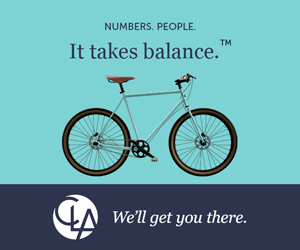Dressing for success can be puzzling, but rewarding

How casual is too casual? How much attention should I pay to the trends? How are my clients judging me based on what I wear? Every day, people working in Greater Des Moines have a lot to consider when they look into their closets and decide what to wear.
Workplace fashion and professional appearance are an important part of people’s business lives, whether they acknowledge it or not. Nationally, workplace dress standards are becoming more professional, and as a result, some people see casual days as being on their last leg. Greater Des Moines has remained untouched by some workplace fashion trends, while others have found their way on to the local scene. What follows is what industry experts and companies are saying about the effects that fashion and workplace dress standards are having on how people dress and do business.
DON’T FORGET THE DETAILS
From sales negotiations to court cases, the difference between victory and defeat can lie in the details – and not necessarily the details in your words, but in your appearance. As fashion trends come and go, one way for people to give their look an update, while at the same time communicating positive personality attributes, is in paying attention to the “finishing touches,” such as shoes, belts and accessories.
“Clothes communicate,” said Deborah Rinner, an executive training specialist on corporate etiquette and international protocol for West Des Moines-based Tero International Inc. “Studies have also suggested that accessories are the most important things that impact the perception that people make of us. People will make some judgments based on the quality our shoes, belts, purses and portfolios.”
Rinner cites a 1960s study of face-to-face communications by University of California, Los Angeles professor Albert Mehradian. That study, which has been replicated numerous times, found that when people meet, 55 percent of the impact that people have on each other is in what the other person sees. Vocal quality accounts for 38 percent of the impact people have on each other, and only 7 percent comes from what is actually said. Rinner said non-verbal body language would factor into appearance as well, but a large part of a person’s perception of us is how well we are dressed.
“We could be the most skilled person in the world, but if we don’t give the visual perception to go along with that, it could be a hindrance to us,” Rinner said. “When you get dressed in the morning, ask yourself, ‘What will what I’m wearing today communicate about my company and my professionalism?’”
Rinner says that as people detail cars, they need to detail themselves, too. Attorney Tim Pearson, a partner with Laden & Pearson PC, says he believes in “dressing sharp to play sharp.”
“I think that what you wear often says who you are or whom you represent,” Pearson said. “You want to project a positive image and have people listen to what you say. If you’re coming in to court with a wrinkled coat and pants that don’t match, your clothes are going to be a distraction. If you’re dressed appropriately, it sure can’t hurt you.”
Amanda Gorsche Miller, a public relations specialist for Flynn Wright, says she agrees that having a well-put-together look can be beneficial with clients, especially in her profession.
“My perception is the people in the advertising and public relations industry do try to dress very professionally and look very modern and nice in general,” Gorsche Miller said. “Communicating is our job, and I think that if you present a professional appearance and you make an effort to look nice all the way down to your shoes, purse or coat, it can convey to clients that you are detail oriented because you pay attention to the details on yourself.”
Gorsche Miller said that regardless of age, integrity and experience are conveyed by dressing professionally. This can work in favor of people who are new to a company or who look younger than their actual age. Also, she said, dressing professionally and having a cohesive look can communicate credibility.
“The facts are that the way you look matters in the world, especially in the business world,” she said. “The more professional an appearance you can portray, the more successful you’ll likely be. I feel like I if I am dressed professionally or wearing something that is in style at the moment, I in turn feel more confident about myself, and the more confident I feel, the better I think I am about doing my job.”
Jill Maahs, a personal shopper at Younkers’ Valley West Mall store, says in the last year and a half, she has worked with many men and women who want to “step up their image.” She says she encourages her clients to invest in at least two pairs of new shoes to go with their new looks.
“Everybody gets a shoe lecture when they come in,” Maahs said. “I’m a fanatic about shoes because I think it finishes the outfit, and it’s an important thing to spend your money on because it’s your feet, which affect your legs and your back, too. I’m not saying to spend a $150 on shoes, but don’t shy away from the $70 pair.”
OPEN TO SUGGESTIONS
Maahs said many of her clients want classic looks in their wardrobe, but they still want to feel fashionable.
“I get a ton of calls from women in their late 20s and 30s and they don’t know what to do because they want to look hip and up to date, but they want to be taken seriously, too,” she said. “You can keep your sense of creativity and be taken seriously too. We try to work with what they are comfortable with and what they are able to do at work.”
Maahs said she recommends less traditional hemlines and pleats for some of her younger clients, and attractive accessories to let the person’s personality come through. She says women tend to have it a little easier than men when it comes to suits, because the styles don’t change much from one year to the next.
“Women’s suits don’t go through the phases,” Maahs said. “You’re always going to see a double-breasted suit or single button. With suits, you’re really not going to go wrong. You just change what goes under it.”
Men face a different challenge because suit coat styles come into and go out of fashion, she said.
“For the longest time, it was two-button and then three-button, and I know that it’s now going to four-button,” Maahs said. “You’re probably not going to see an accountant or a lawyer in a four-button suit because it’s a more updated look when they’re going to be in a more conservative cut.”
Maahs said tweed is popular right now in women’s suits, but many women are only buying a jacket and sticking with a solid-colored skirt or pants to match. Also, houndstooth (the little black and white checked pattern) and pinstripe suits are hot right now, she said.
Dave Lemons, president of Midwest Clothiers, said no matter which style of suit men choose to buy, there is one simple rule to remember.
“For men, if you have to wear suits once in a while, buy the best suit that you can afford,” Lemons said. “There’s a big difference in how they look, feel and last as you go up the scale, and you’ll feel better wearing them.”
Lemons, whose company operates six stores, including Reichardt’s Clothing, said he has seen a movement toward more color in men’s clothing.
“Men are starting to wear a lot more color in the last couple of years than in the past,” Lemons said. “The ties are much more bright and striped. Dress shirts are the same way.”
Maahs said the most common profession among her clients is human resources. She says because these HR people often promulgate company policies, they sometimes feel pressure to set the tone for the whole office, which leads them to seek her wardrobe advice.
“I think they feel like they have to set a standard for everyone else,” she said. “If people see them dressing a certain way, then it encourages the other people. And, they are sometimes the first contact potential employees have with the company as well, so they want to be sure they’re representing the company well with their appearance.”
Another area of concern for working professionals has been how to dress for business casual and casual days in the workplace.
CONFUSION OVER CASUAL
According to a study last year by Dennis Tootelian, a marketing professor at California State University, Sacramento, nearly two-thirds of Americans have felt inappropriately dressed at a business or social function and more than two-thirds are uncertain about the differences among business attire, business casual and casual dress in the workplace.
In Des Moines, the definitions differ by company. At Ernst & Young LLP, Mike Fliehe, the human resources director for the accounting firm’s Des Moines operations, says his company’s policy is “probably a little more strict than most downtown.”
“We are business casual with casual Fridays, but we recommend that men wear collared shirts and dress coats and slacks as opposed to khakis,” he said. “We’re outside the office 90 percent of the time, and when we’re meeting with a client, we’re always dressing at or above their level.”
At Allied Insurance, spokesman Mike Palmer said his company’s business casual and casual Fridays translate into “not wearing jeans or more casual clothing during the majority of the week.” For men, business casual would typically mean khaki pants and button-down shirts, and for women, probably casual slacks and a sweater or casual blouse.
At Communications Data Services Inc., where dress codes are a mix of business casual and casual, based on the employee’s role, department managers “reserve the right to further outline dress codes, even if the employees have little to no client contact,” said Linda Carter-Lewis, the company’s employee relations manager.
Tero International’s Rinner, who holds meetings with companies and professional groups to discuss workplace attire, says she has listened to a lot of concerns from employees who are unclertain about what is appropriate for business casual and casual standards.
“Companies sometimes assume that everybody has the same framework in their mind about what is appropriate, but different generations, backgrounds and gender affect each person’s dialogue,” Rinner said. “It’s not about having rules and regulations as much as having a dialogue within the company about how the organization wants to be represented in the community.”
Rinner said casual days have been a foggy area for employees, which leaves room for mistakes to be made.
“A lot of companies have implemented casual days as a bonus for employees, but it causes some challenges in regards to what’s going to fit with the standards of the company and still represent the company well,” she said. “I think that people want to represent themselves in the best light, but they might not be aware of how to go about it.”
National trends suggest that the pendulum is swinging away from casual. Fliehe has noticed that Ernst & Young’s East Coast clients have stepped up their dress codes recently, which in turn reminds his firm’s employees follow suit when traveling to work with those clients.
“It just seems like more and more companies on the East Coast are going professional; therefore, our employees are dressing more professional because they’re meeting with clients,” Fliehe said. “Part of being professional is looking the part.”
In the end, if someone is still unclear on how to dress for success and make a good impression both in their workplace and in client interactions, Midwest Clothiers’ Lemons has some clear advice.
“I would typically say that you’re better off dressing for the job that you want rather than the job that you have,” he said. “It will always be a benefit to you to be a little more well-dressed and appear more professional than you have to be.”







